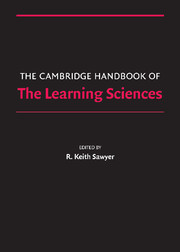Book contents
- Frontmatter
- Contents
- Preface
- Contributors
- 1 Introduction
- PART I FOUNDATIONS
- PART II METHODOLOGIES
- 8 Learner-Centered Design
- 9 The Evolution of Design Studies as Methodology
- 10 Design-Based Research
- 11 Guiding Inquiry-Based Math Learning
- 12 Analyzing Collaborative Discourse
- 13 Assessing for Deep Understanding
- PART III THE NATURE OF KNOWLEDGE
- PART IV MAKING KNOWLEDGE VISIBLE
- PART V LEARNING TOGETHER
- PART VI LEARNING ENVIRONMENTS
- Afterword: After How Comes What
- Epilogue: The Fundamental Issue in the Learning Sciences
- Author Index
- Subject Index
- References
11 - Guiding Inquiry-Based Math Learning
Published online by Cambridge University Press: 05 June 2012
- Frontmatter
- Contents
- Preface
- Contributors
- 1 Introduction
- PART I FOUNDATIONS
- PART II METHODOLOGIES
- 8 Learner-Centered Design
- 9 The Evolution of Design Studies as Methodology
- 10 Design-Based Research
- 11 Guiding Inquiry-Based Math Learning
- 12 Analyzing Collaborative Discourse
- 13 Assessing for Deep Understanding
- PART III THE NATURE OF KNOWLEDGE
- PART IV MAKING KNOWLEDGE VISIBLE
- PART V LEARNING TOGETHER
- PART VI LEARNING ENVIRONMENTS
- Afterword: After How Comes What
- Epilogue: The Fundamental Issue in the Learning Sciences
- Author Index
- Subject Index
- References
Summary
In this chapter, we present a case study of a classroom approach whose development was inspired by learning sciences research. We conducted a sequence of classroom design experiments in urban seventh and eighth grade classrooms (see Barab, this volume, and Confrey, this volume, for discussions of design experiment methodology) focused on teaching and learning statistical data analysis. During this process, we formulated, tested, and revised specific conjectures about both the process of students' learning in the domain of statistics, and ways to scaffold that learning. The primary products of these design experiments were two sequences of instructional activities: one that focused on the analysis of univariate data and one on bivariate data, and three computer-based data analysis tools that were used in both. In this chapter, we restrict our focus to the first of the two classroom design experiments – the one focused on the analysis of univariate data.
We start by critically examining the traditional instructional goals of middle school math. Learning sciences research rejects a conception of knowledge as consisting of facts and procedures to be memorized; unfortunately, this traditional style of instruction still predominates in most mathematics classrooms. As part of this discussion, we briefly summarize recent developments in both the use of statistics in wider society and in statistics as a discipline. We then describe the initial assessments of students' statistical reasoning, and contrast them with the concluding assessments.
Information
- Type
- Chapter
- Information
- The Cambridge Handbook of the Learning Sciences , pp. 171 - 186Publisher: Cambridge University PressPrint publication year: 2005
References
Accessibility standard: Unknown
Why this information is here
This section outlines the accessibility features of this content - including support for screen readers, full keyboard navigation and high-contrast display options. This may not be relevant for you.Accessibility Information
- 3
- Cited by
